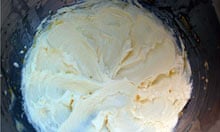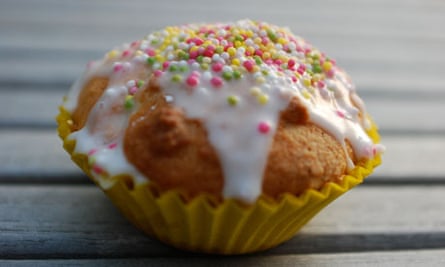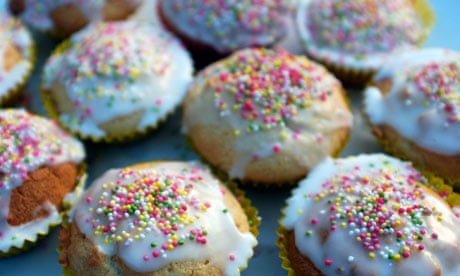Somewhere around the turn of the century the fairy cake, like some artificially leavened red squirrel, became the victim of an alien invasion from across the Atlantic. I refer, of course, to the dreaded cupcake. The blame for these overgrown baked goods, piled high with tooth-achingly sugary icing, can be blamed, along with giant corsages and 'I'm mad me' shoe-fetishes, squarely at the (presumably) bunioned feet of Sarah Jessica Parker, who was seen cramming one into her mouth in season three of Sex and the City. How could our own dainty little native fairies hope to compete with such all-American behemoths?
Of course, there are those who argue that the two are basically one cake divided by a common language. These people have clearly never tried to finish a red velvet cupcake, once memorably described by Xanthe Clay as the Dolly Parton of the baking world: "artificially coloured, unashamedly vulgar and absolutely irresistible".
Mich Turner, of the Little Venice Cake Company, who has baked for everyone from HM the Queen to the ill-fated nuptials of Cheryl Tweedy and Ashley Cole and who is currently promoting the fairy cake on behalf of Nature Friendly Flour, is firm on the point. "They are very different," she tells me. For a start, cupcakes tend to be much larger, and more importantly, in Mich's opinion, they have the wrong icing: great wodges of lurid buttercream, rather than the traditional non-fat glace stuff. Talking to her, the cupcake, in all its garish permutations, suddenly seems faintly repulsive.
Instead, I'm keen to try and perfect the fairy cakes of childish parties, where the sponge was the star, not the 'frosting'. To this end, I've dusted off some small tins, and mugged up on traditional glace icing – all I have to do now is decide on a cake recipe. The basic formula seems straightforward enough; roughly equal amounts of butter, sugar and flour, plus egg, and sometimes milk or water, to loosen the mixture. But after looking at a few cookbooks, I begin to spot significant variations.
All rise …
There's the question of raising agents, for a start. Some people use self-raising flour, some use plain flour plus baking powder and many, like Allegra McEvedy and Mich herself, use self-raising flour and baking powder to give the mixture a bit of a boost. I decide to give all three methods a try, using a fairy cake recipe from Leiths Baking Bible.
Unsurprisingly, there's not much difference between the first two recipes, self-raising flour being just plain flour with added baking powder, but the extra baking powder definitely gives the cakes a few extra millimetres of height. Not only does this mean a more pleasingly pointy top (Mich prefers flat surfaces, because they can be decorated more easily, whereas the more cake the better as far as I'm concerned), but also a lighter texture. Baking powder is definitely a good thing.
Egg v milk
There's little agreement over which liquid to use either. Some recipes call for two eggs to get the mixture to the desired 'dropping consistency' before baking (this means that it will drop slowly off the spoon, rather than running off easily, or sticking completely), while others prefer milk or even water. The Leiths fairy cake recipe I've been using contains just one egg, plus milk "to mix", so I decide to double the egg content, as in their Victoria Sponge recipe.
This gives a rich, slightly dense result which, in my opinion, is entirely appropriate for the queen of the tea table, but rather less so for the frippery that is a fairy cake, which ought, I think, to be featherlight in texture. Swapping the milk for water seemed to give a marginally less fluffy sponge, although depending on the size of your eggs, you might not use enough to make much of a difference.
Trade secrets
Leiths suggest I replace a little of the flour – roughly a quarter – with ground rice, which gives the finished cakes a pleasingly crunchy texture. Nice as it is, I don't think it's right for a classic fairy cake, although I would recommend giving it a try if you're a fan of a crisper crumb. Online, Good Food's Angela Nilsen suggests adding ground almonds instead, which release their oil as the cake bakes, helping to keep it nice and moist. As fairy cakes can tend to dryness, thanks to their large surface area, this can only be a good thing, but I find her ratio (140g of flour to 100g almonds) gives a slightly heavy cake, so I reduce it to 1:4, with much better results.
To rest or not to rest?
Now I've decided on my ingredients it's time to turn my attention to the best way to make them into a cake. Although most creaming method recipes urge you to get the mixture into the oven as quickly as possible, Dan Lepard, somewhat mysteriously, calls for a 30 minute resting time for the batter before cooking. I try this, but am unable to see any particular benefit; in fact, oddly enough, some of the cakes are distinctly less well risen than their non-rested counterparts. I ask a baker friend who specialises in fairy cakes for weddings, and she suggests that leaving the mixture will help to give the more easily decorated flat top beloved of the professionals.
The importance of creaming

I learn something vital during my baking class with Mich (as well as the fact that I will never have a delicate enough hand to turn out sugar ladybirds which look winsome, rather than plain horrifying). When a recipe tells you to cream together the butter and sugar until light and fluffy, it really means it; Mich has me turn the food mixer up to full power for almost five minutes, until the mixture is positively billowing, which means when I gradually add the eggs, it takes on the appearance of a meringue. I can see air bubbles popping as I fold in the flour, which is exactly the point – a nice light sponge needs as much air in it as possible.
Icing
In terms of icing, a simple glace one, which can be coloured or decorated as you see fit, works best with a fairy cake in my opinion – buttercream should be saved for inferior versions which deserve to be overwhelmed by its sugary richness. For 12 cakes, you'll need 225g icing sugar, mixed with boiling water to create a thick paste. Slather it on to the cooled cakes, then go mad with the hundreds and thousands.
Fairy cakes, or cupcakes, are the easiest, but perhaps also the most joyous of cakes – they never fail to make people smile. Call them whatever you like, but keep the sponge nice and light, and the decoration simple, and you really can't go wrong.
Felicity's perfect fairy cakes

Makes 12 small cakes or 6 large ones.
85g unsalted butter, softened
85g golden caster sugar
1 medium egg
100g self-raising flour, sifted
40g ground almonds
¼ tsp baking powder
100ml milk, to mix (you might not need it all)
225g icing sugar
Decorations of your choice
1. Line a fairy cake or muffin tin with cases, and heat the oven to 180C.
2. Cream the butter and sugar together until light and fluffy – if you do this by hand you'll need a very strong arm, so if you've got one use a food mixer on its fastest setting.
3. While continuing to mix, drizzle the egg in gradually, adding a tablespoon of flour if the mixture looks like it's about to curdle.
4. Combine the flour, almonds and baking powder, then gently fold into the mixture. Add just enough milk to bring the batter to a dropping consistency.
5. Divide the mixture between the cases: if you prefer flat-topped cakes, then just cover the bottom of the cases, if not, you can half-fill them.
6. Bake for 20 minutes, and then turn out on to a rack to cool.
7. Mix the icing sugar with enough boiling water to make a thick paste, then smooth over the cooled cakes, and add decorations before it sets. Eat quickly – fairy cakes don't keep!

Comments (…)
Sign in or create your Guardian account to join the discussion